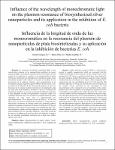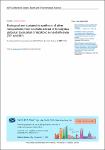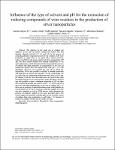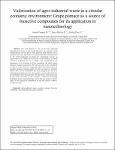Mostrar el registro sencillo del ítem
Influence of the wavelength of monochromatic light on the plasmon resonance of biosynthesized silver nanoparticles and its application in the inhibition of E. coli bacteria [Influencia de la longitud de onda de luz monocromática en la resonancia del plasmón de nanopartículas de plata biosíntetizadas y su aplicación en la inhibición de bacterias E. coli]
| dc.contributor.author | Asmat Campos, David Angel | |
| dc.contributor.author | Mora Alva, Oscar Artemio | |
| dc.contributor.author | Robles Castillo, Heber Max | |
| dc.date.accessioned | 2023-10-17T17:12:15Z | |
| dc.date.available | 2023-10-17T17:12:15Z | |
| dc.date.issued | 2021-09-08 | |
| dc.identifier.citation | Asmat, D. A., Mora, O. A., Robles, X. M. (2021). Influence of the wavelength of monochromatic light on the plasmon resonance of biosynthesized silver nanoparticles and its application in the inhibition of E. coli bacteria [Influencia de la longitud de onda de luz monocromática en la resonancia del plasmón de nanopartículas de plata biosíntetizadas y su aplicación en la inhibición de bacterias E. coli]. Latin American and Caribbean Consortium of Engineering Institutions, 2021-July(53). http://dx.doi.org/10.18687/LACCEI2021.1.1.53 | es_PE |
| dc.identifier.other | . | es_PE |
| dc.identifier.uri | https://hdl.handle.net/11537/34535 | |
| dc.description.abstract | La resonancia de plasmón superficial (RPS) es una característica presente en las nanopartículas metálicas las cuales están asociadas a la oscilación colectiva de electrones libres. En este trabajo de investigación se considera a las nanopartículas de plata (NP Ag) las cuales han sido obtenidas por el método de síntesis verde (biosíntesis) usando como reductor el extracto de residuos de uva proveniente de la industria vinícola; estas nanopartículas en la investigación juegan el papel de agente inhibidor de bacterias E. Coli. La eficiencia de inhibición de las NP Ag puede aumentar en base a la frecuencia de la energía incidente motivado por la longitud de onda de cada color monocromático, elevando el nivel de oscilación del plasmón de superficie, es así como se investiga la influencia en función a siete longitudes de onda correspondientes al espectro visible. Los resultados muestran una correcta síntesis de nanopartículas de plata obtenidas por ruta verde, pues la caracterización por espectrofotometría UV-vis muestra el pico de RPS en 422.61 nm típico para este tipo de nanomaterial; asimismo, la evaluación por microscopía electrónica de barrido señala una geometría esférica definida con tamaño promedio de 32.66 nm; el efecto de la NP Ag con influencia de luz sugiere una alta eficiencia en la inhibición de E. Coli, específicamente cuando está bajo influencia de la longitud de onda monocromática azul (11.2 mm halo inhibición – 69.6% por encima de la muestra sin influencia de luz).Este efecto de inhibición se suma a las ya conocidas propiedades intrínsecas de la plata para inhibir agentes bacterianos. | es_PE |
| dc.description.abstract | Surface plasmon resonance (SPR) is a characteristic present in metallic nanoparticles which are associated with the collective oscillation of free electrons. In this research work, silver nanoparticles (NP Ag) are considered, which have been obtained by the green synthesis method (biosynthesis) using the extract of grape residues from the wine industry as a reducer; These nanoparticles in research play the role of inhibiting agent of E. Coli bacteria. The inhibition efficiency of NP Ag can increase based on the frequency of the incident energy motivated by the wavelength of each monochromatic color, raising the level of oscillation of the surface plasmon, this is how the influence is investigated as a function of seven wavelengths corresponding to the visible spectrum. The results show a correct synthesis of silver nanoparticles obtained by the green route, since the characterization by UV-vis spectrophotometry shows the RPS peak at 422.61 nm typical for this type of nanomaterial; Likewise, the evaluation by scanning electron microscopy indicates a defined spherical geometry with an average size of 32.66 nm; the effect of NP Ag with light influence suggests a high efficiency in the inhibition of E. Coli, specifically when it is under the influence of the Monochromatic blue wavelength (11.2 mm halo inhibition - 69.6% above the sample without influence of light). This inhibiting effect adds to the already known intrinsic properties of silver to inhibit bacterial agents. | es_PE |
| dc.format | application/pdf | es_PE |
| dc.language.iso | spa | es_PE |
| dc.publisher | Latin American and Caribbean Consortium of Engineering Institutions | es_PE |
| dc.rights | info:eu-repo/semantics/openAccess | es_PE |
| dc.rights | Atribución-NoComercial-CompartirIgual 3.0 Estados Unidos de América | * |
| dc.rights.uri | https://creativecommons.org/licenses/by-nc-sa/3.0/us/ | * |
| dc.source | Universidad Privada del Norte | es_PE |
| dc.source | Repositorio Institucional - UPN | es_PE |
| dc.subject | Nanopartículas de plata | es_PE |
| dc.subject | Síntesis verde | es_PE |
| dc.subject | Efecto antibacterial | es_PE |
| dc.subject | Inhibición bacterial | es_PE |
| dc.subject | Longitud de onda | es_PE |
| dc.title | Influence of the wavelength of monochromatic light on the plasmon resonance of biosynthesized silver nanoparticles and its application in the inhibition of E. coli bacteria [Influencia de la longitud de onda de luz monocromática en la resonancia del plasmón de nanopartículas de plata biosíntetizadas y su aplicación en la inhibición de bacterias E. coli] | es_PE |
| dc.type | info:eu-repo/semantics/conferenceObject | es_PE |
| dc.publisher.country | PE | es_PE |
| dc.identifier.journal | Proceedings of the LACCEI International Multi-conference for Engineering, Education and Technology | es_PE |
| dc.subject.ocde | https://purl.org/pe-repo/ocde/ford#3.01.00 | es_PE |
| dc.description.sede | Trujillo El Molino | es_PE |
| dc.identifier.doi | http://dx.doi.org/10.18687/LACCEI2021.1.1.53 |







